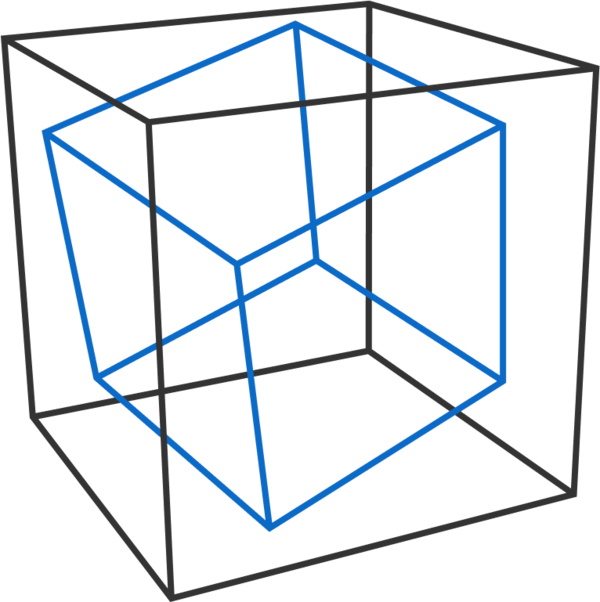Cube Inscribed In Cube

A cube is inscribed in a unit cube so that exactly 6 of the inscribed cube's 8 vertices each touch a different face of the unit cube.
What's the smallest cube that can be inscribed in this way?
If its side length can be expressed as b a , where a and b are coprime positive integers, give the product a × b as the answer.
The answer is 15.
This section requires Javascript.
You are seeing this because something didn't load right. We suggest you, (a) try
refreshing the page, (b) enabling javascript if it is disabled on your browser and,
finally, (c)
loading the
non-javascript version of this page
. We're sorry about the hassle.
2 solutions
Another aproach, just to coment because I putted the answer wrong so I'm no able to explain my solution, would be using cartesian cordinantes in the center of the squares (wich must be the same point). So that the inscribed cube is a rotation of an angle of t along the axis described by the unit vector u=(u x,u y,u z), which can be descrived by the rotational matrix R(u,t), (see: https://en.wikipedia.org/wiki/Rotation matrix), plus a contraction of the factor c (which would be also the side lenght of the new cube).
Then we have the condition of the vertices of the inscrived cube lying on the faces of the larger cube, we have 6 equation, one for each face, but since we assume that opposite vertices lie on oposite faces and if one vertice lies in a face the opposite also does by simetry (recall that the centers of the cubes are the same), this reduces the sistem to only 3 equations with the 3 variables u x,u y and u_z plus the condition ||u||=1 and the variable t, a part from the "constat" c.
Plaing a bit with the algebra (to specify, adding the 3 equations, which you may not have in mind, together and then aplying rearrangement inequality) we can get to the expression c<=3/(1-4cost)<=3/5 whit the equality holding when u x=u y=u_z=sqrt(3)/3 and t=180º thus c=3/5 is the desired minum.
In conclusion we've learned that the desired situation of the inscrived cube is achived with a half turn (rotation of 180º) of the large cube along the axis of one of its space diagonals, plus an escalation of the factor 3/5.
I think you are missing a square root over a 2? Surely the diagonal is the square root of twice the square of the side. And since you seen to have awesome cube drawing powers, could you add differently coloured lines in there showing more about how you did the Pythagoras relations? It would accelerate the reader's understanding. It seems that the result a + b = 1 hints at another solution, too.
Log in to reply
Let me fix that so that becomes more clear
...better now?
As for your other suggestions, let me see what I can do
Michael,can you recommend a geometry book to me??? I am studying in school
Hey Michael. Can you please further describe how did you come up with your first equilibrium.
Log in to reply
You mean the first equation that must be satisfied? Let me fix that again. The left side is 2 times the edge of the cube, while the right side is the length of the diagonal of one of its faces.
This is amazing. Really mind-blowing. I was thinking about using calculus.
The cube vertices coordinates lying on the face are assumed and the volume of the inscribed cube is minimized to get the desired answer.
improve more
Nice one sir, I love your work sir.
I am speechless
Remember it's a geometry problem. It's not efficient to go calculus way when ur bored tho...(even if you do..be lucid)
The length of the side of the smallest such cube is 5 3 .
The red rectangles in this figure below are all identical, so that vertex-to-vertex distances are similarly identical (see Note).
Let a , b be the dimensions of the red rectangles. Then the squares of the edge and the diagonal of a face of the small cube must satisfy
2 a 2 + ( 1 − b ) 2 + ( b − a ) 2 = b 2 + ( 1 − a ) 2 + ( 1 − a − b ) 2
so that
b = 2 1 ( 1 + 3 a − 1 − 2 a + 5 a 2 )
so that the edge of the small cube has length
1 − 2 a + 6 a 2 − 2 a 1 − 2 a + 5 a 2
the minimum of which is 5 3 , with a = 5 2 and b = 5 3
Note: A loose proof why: To consider any other way a cube can be inscribed other than having all the red rectangles being identical, consider the first two rectangles having dimensions a , b and c , d . Then in succession the rest of the tangent points are determined by the first four variables a , b , c , d , and for it to come back to the point of beginning, two degrees of freedom have to be given up. The resulting box formed in this manner is not necessarily a cube, but could be rhombic in cross section, so in order for it to be a true cube, one more degree of freedom has to be given up. That leaves just one degree of freedom which determines the size of the cube. Ergo, all the red rectangles need to be identical, as that is a solution and therefore the only one.